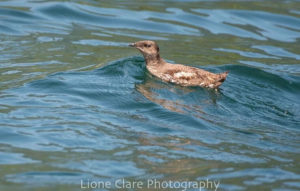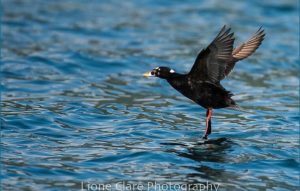We recently got some great photography opportunities of Marbled Murrelets and Surf Scoters, so thought we would share some information about these birds we sometimes see out on Sitka Sound!
Marbled Murrelet
 This small alcid (9 ½ “ – 12 “ long with a wingspan of 14” – 16” ), can fly up to 100mph. Its habit of nesting in old-growth forest trees was suspected but not documented until a tree-climber found a chick in 1974, making it one of the last North American bird species to have its nest described. The marbled murrelet has declined in number since humans began logging its nest trees in the latter half of the 19th century. They have only one egg and when the murrelet chick fledges it makes its way up to 40 miles to the sea.
This small alcid (9 ½ “ – 12 “ long with a wingspan of 14” – 16” ), can fly up to 100mph. Its habit of nesting in old-growth forest trees was suspected but not documented until a tree-climber found a chick in 1974, making it one of the last North American bird species to have its nest described. The marbled murrelet has declined in number since humans began logging its nest trees in the latter half of the 19th century. They have only one egg and when the murrelet chick fledges it makes its way up to 40 miles to the sea.
So, as you can see this fragile little bird has many obstacles to overcome to survive and has become a flagship species for forest preservation groups It is considered an endangered species in the lower 48 and a species of least concern in Alaska as Sitka is Ground Zero for studying this locally abundant species.
Surf Scoter
 The so-called “Skunk-head” is the only one of the three scoters confined to the New World. These birds are often seen diving for mollusks and crustaceans along the line of breaking surf. The bold white patches on the male’s head are used in displays; a bird may threaten a rival simply by turning its head and presenting its white nape. they thrive in rough water of a different kind, riding the surf in toward rocky cliffs, and wrenching mussels, chitons, barnacles, and other attached animals from the surface, and diving for crabs and other crustaceans. Swift-moving streams in summer; rocky, wave-lashed coasts and jetties in winter. Prefers to forage close to shore, often within 50 feet. They rarely vocalize except during courtship.
The so-called “Skunk-head” is the only one of the three scoters confined to the New World. These birds are often seen diving for mollusks and crustaceans along the line of breaking surf. The bold white patches on the male’s head are used in displays; a bird may threaten a rival simply by turning its head and presenting its white nape. they thrive in rough water of a different kind, riding the surf in toward rocky cliffs, and wrenching mussels, chitons, barnacles, and other attached animals from the surface, and diving for crabs and other crustaceans. Swift-moving streams in summer; rocky, wave-lashed coasts and jetties in winter. Prefers to forage close to shore, often within 50 feet. They rarely vocalize except during courtship.
